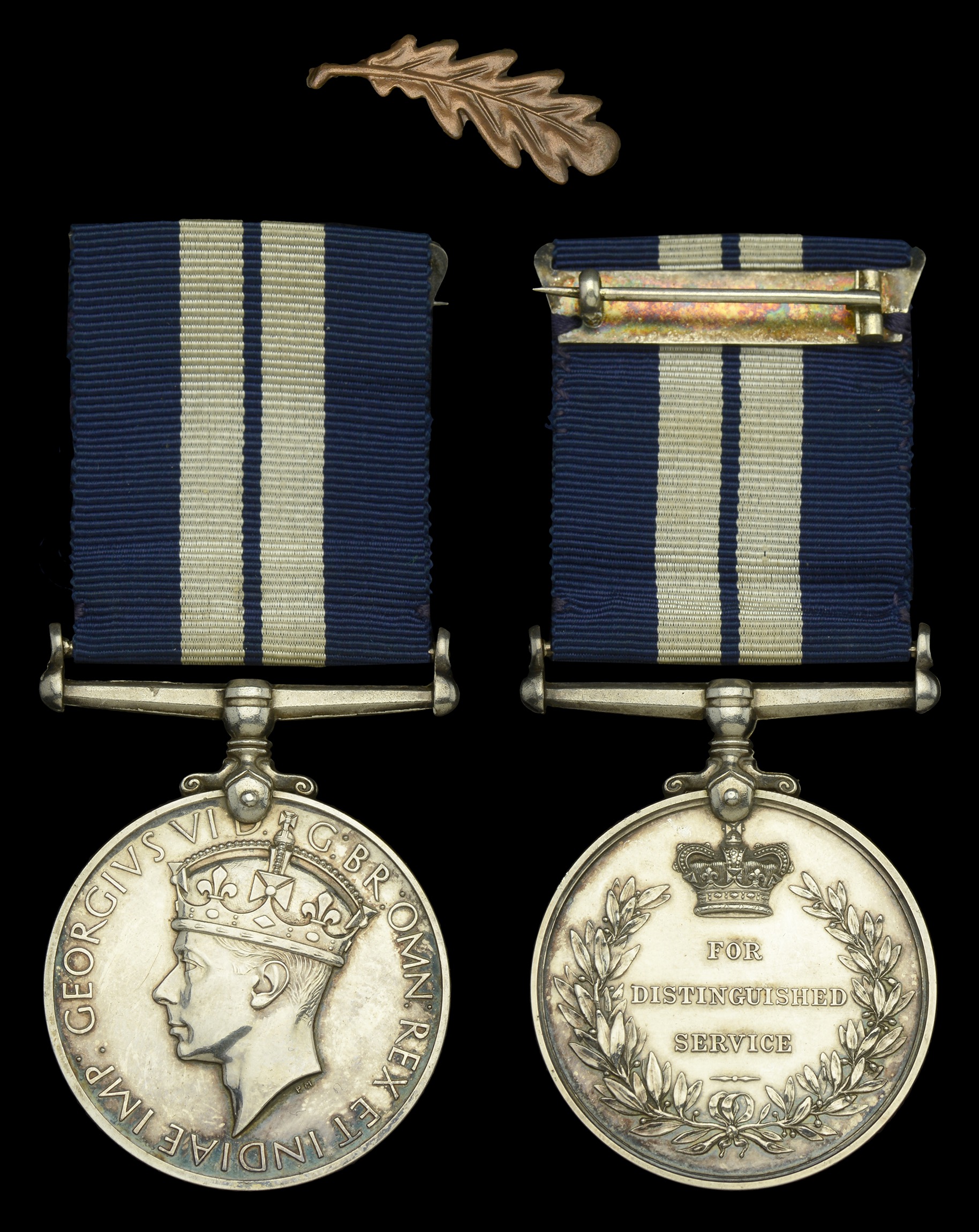A Second War D.S.M. awarded to Chief Stoker J. E. Martin, Royal Navy, who was decorated for his gallantry in the destroyer H.M.S. Lively in the 2nd battle of the Sirte Distinguished Service Medal, G.VI.R. (KX. 86830 J. E. Martin. Ch. Sto.) impressed naming, together with M.I.D. oak leaf, extremely fine £700-£900 --- Importation Duty This lot is subject to importation duty of 5% on the hammer price unless exported outside the UK --- --- Provenance: Spink, November 1998. D.S.M. London Gazette 8 September 1942: ‘For gallantry, skill and seamanship in a brilliant action against strong enemy forces, which were driven off and severely damaged. This action resulted in the safe passage to Malta of an important Convoy.’ The original recommendation states: ‘Chief Stoker Martin was instrumental in extinguishing the fire in the top of the funnel. When the ship was holed forward by a splinter from a 15-inch shell, Martin acted with great promptness in shoring up bulkheads and hatches. He was tireless in organising the necessary pumping to keep the flooding under control and his example of cheerfulness, energy and coolness was most inspiring to the men working with him. He carried out all the above in addition to his normal duties of supervising the fuel and boiler-water situation.’ Joseph Edward Martin likely joined the destroyer H.M.S. Lively on the eve of her tour of operations in the Mediterranean in September 1941. Lively first came to prominence for her part in a brilliant victory achieved by Force ‘K’ on 8 November 1941, when - assisted by ‘Ultra’ radar - the cruisers Aurora and Penelope, in company with the Lively and Lance, manoeuvred into a favourable position to engage an Italian convoy. By dawn, Force ‘K’ had sunk all seven enemy transports and one of their destroyers, the Fulmine. It was for this spectacular night action that Martin was mentioned in despatches (London Gazette 24 February 1942, refers). Just over two weeks later, Lively was back in action, participating in the destruction of two enemy supply ships, a result largely made possible by the cunning of her Petty Officer Telegraphist, James Griffin, who was able to note, to the amusement of his shipmates, the call signs of two enemy shore bases and a prowling aircraft. He then took a hand in the enemy’s W./T. organisation and, making use of their call signs, controlled the traffic, following the enemy procedure carefully. The enemy apparently accepted this state of affairs and order was resumed out of a chaos of wireless chatter by Lively controlling the transmitting stations to silence, which was preserved for half and hour. A later attempt by the Italians to renew wireless activity was met with an angry interjection by Griffin, who, clearly warming to his new-found task as Acting Enemy Wireless Controller, was pleased to find the Italians quickly obeyed. Griffin was awarded the D.S.M., a distinction shortly to be shared by Martin. Undoubtedly Lively’s finest moment occurred in the 2nd battle of the Sirte, fought between a Malta convoy escort under Admiral Sir Philip Vian, and a far superior Italian force. On 22 March 1942, in a game of cat and mouse, Vian succeeded in protecting his merchantmen from the serious threat posed by the Italian battleship Littorio, and it was his destroyers that led the way: ‘By this time the sea had risen appreciably and the Sikh, Lively and Hero, as they closed to engage the enemy, were rolling and pitching violently and their decks were swept with solid water as the waves broke over them. They attacked their overwhelming adversary with guns and torpedoes - three destroyers pitted against a battleship, three cruisers, and six destroyers - and at the same time extended the smoke-screen westward to cover the now threatened merchantmen ...’ (Victory at Sea, by Lieutenant-Commander P. K. Kemp, refers). It was at this stage, as the smoke-screen started to take effect, that the mighty Littorio barked back in anger, her 15-inch shells damaging a number of the R.N. escorts, Vian’s Cleopatra and the plucky Lively among them. Rapidly responding to a fire in the top of Lively’s funnel, Martin commenced a series of damage-control procedures that would result in his award of the D.S.M. On the afternoon of 11 May 1942, while patrolling between Crete and Libya, she received at least two direct hits from enemy aircraft and turned over and sank in four minutes. Her Captain, Lieutenant-Commander W. F. E. Hussey, D.S.O., D.S.C., who had penned Martin’s recommendation just over a month earlier, was among the 65 crew members who lost their lives. Thus ended Lively’s impressive spate of activity on the Mediterranean station. Martin survived that ordeal and received his D.S.M. at a Buckingham Palace investiture held in March 1944. Sold with copied research.





